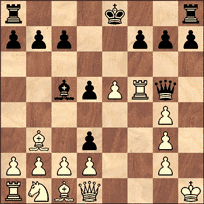
When contacting us by e-mail, correspondents are asked to include their name and full postal address and, when providing information, to quote exact book and magazine sources. The word ‘chess’ needs to appear in the subject-line or in the message itself.
| First column | << previous | Archives [1] | next >> | Current column |
In C.N. 954 a correspondent in the United Kingdom, Paul Timson, discussed the following game, said to have been played between Adolf Anderssen and Max Lange in Breslau, 1859:
1 e4 e5 2 Nf3 Nc6 3 Bb5 Nd4 4 Nxd4 exd4 5 Bc4 Nf6 6 e5 d5 7 Bb3 Bg4 8 f3 Ne4 9 O-O d3 10 fxg4 Bc5+ 11 Kh1 Ng3+ 12 hxg3 Qg5 13 Rf5 h5 14 gxh5 Qxf5 15 g4 Rxh5+ 16 gxh5 Qe4 17 Qf3 Qh4+ 18 Qh3 Qe1+ 19 Kh2 Bg1+ 20 Kh1 Bf2+ 21 Kh2 Qg1 mate.
Concerning discrepancies in the moves in various sources, see pages 190-191 and page 269 of Chess Explorations.
The game was not included in H. von Gottschall’s monograph on Anderssen, but we now note that the following appeared on pages 278-279 of Schachjahrbuch für 1917/18 by L. Bachmann (Ansbach, 1919):
Adolf Anderssen – Jean Dufresne
Berlin, ‘1851?’
Ruy López
1 e4 e5 2 Nf3 Nc6 3 Bb5 Nd4 4 Nxd4 exd4 5 Bc4 Nf6 6 e5 d5 7 Bb3 Bg4 8 f3 Ne4 9 O-O d3 10 fxg4 Bc5+ 11 Kh1 Ng3+ 12 hxg3 Qg5 13 Rf5

13...h5 14 White resigns.
From a mid-1960s issue of CHESS:
‘He has the lamentable distinction of being – throughout the English-speaking world, anyway – the most under-estimated chess writer in the world.’
We leave readers a few days to consider who was being discussed.
The Anderssen v Dufresne game in C.N. 3412 was one of nearly 50 scores absent from H. von Gottschall’s 1912 monograph on Anderssen which were given by L. Bachmann on pages 278-317 of Schachjahrbuch für 1917/18 (Ansbach, 1919). Below is a selection of some which seem ‘unknown’ even today.
Adolf Anderssen – Augustus Mongrédien
London, 30 May 1851
King’s Gambit Accepted
1 e4 e5 2 f4 exf4 3 Nf3 g5 4 h4 g4 5 Ng5 h5 6 Bc4 Nh6 7 d4 f6 8 Bxf4 fxg5 9 hxg5 Nf7 10 g6 Ng5 11 Be5 d5 12 Bxd5
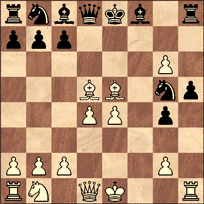
12...c6 13 Bf7+ Nxf7 14 gxf7+ Kxf7 15 Bxh8 Bh6 16 O-O+ Kg8 17 Bf6 Qe8 18 Nc3 Nd7 19 e5 Nf8 20 Qd3 Be6 21 Ne4 Qg6 22 Be7 Kh8 23 Rf6 Qg7 24 Bxf8 Rxf8 25 Rxe6 h4 26 Nf6 h3 27 Rd6 h2+ 28 Kh1 Resigns.
Augustus Mongrédien – Adolf Anderssen
London, 30 May 1851
Bishop’s Opening
1 e4 e5 2 Bc4 b5 3 Bxb5 c6 4 Ba4 Bc5 5 Bb3 Nf6 6 Nc3 d5 7 exd5 O-O 8 h3 cxd5 9 d3 Nc6 10 Nge2 d4 11 Ne4 Nxe4 12 dxe4 Kh8 13 Ng3 f5 14 exf5 Bxf5 15 Nxf5 Rxf5 16 Qg4 Bb4+ 17 Kf1 Qf6 18 f3 e4 19 Ke2 exf3+ 20 gxf3 Re8+ 21 Kf2 Ne5 22 White resigns.
Adolf Anderssen – F.E. Greenaway
London, 16 June 1851
King’s Gambit Accepted
1 e4 e5 2 f4 exf4 3 Nf3 g5 4 h4 g4 5 Ne5 h5 6 Bc4 Nh6 7 d4 d6 8 Nd3 f3 9 gxf3 Be7 10 Be3 Bxh4+ 11 Kd2 gxf3 12 Qxf3 Bg4 13 Qf4 Qf6 14 Nc3 Qxf4 15 Nxf4 Bg5 16 Ncd5 Kd7 17 Nxh5 Bxe3+ 18 Nxe3 Bf3 19 Rh3 Bxh5 20 Rxh5 Nc6 21 Rah1 Nxd4 22 Rxh6 Nf3+ 23 Ke2 Rxh6 24 Rxh6 Ne5 25 Bb3 Re8 26 Rh7 c6 27 Bxf7 Re7 28 Bg8 Rxh7 29 Bxh7 Kc7 30 Bf5 b5 31 Ng4 Nc4 32 b3 Na5 33 Kd3 c5 34 Be6 Nc6 35 c3 Resigns.
Adolf Anderssen – F.E. Greenaway
London, June 1851
King’s Gambit Accepted
1 e4 e5 2 f4 exf4 3 Bc4 Qh4+ 4 Kf1 g5 5 Nc3 Bg7 6 d4 d6 7 Nf3 Qh5 8 h4 h6 9 e5 Bg4 10 Nd5 Kd8 11 Bd2 Nc6 12 Bc3 Nge7 13 Nxe7 Nxe7 14 Kf2 Bxf3 15 gxf3 gxh4 16 Qd2 h3 17 Qxf4 Ng6
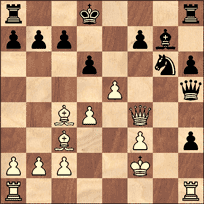
18 Qxf7 Rf8 19 Rag1 Rxf7 20 Bxf7 Qh4+ 21 Kf1 Qf4 22 Bxg6 h2 23 Rxh2 Qxh2 24 Be4 Qh3+ 25 Ke2 Bf8 26 Rg8 Ke7 27 Rh8 Re8 28 Bxb7 Bg7 29 Rh7 Qg2+ 30 Kd1 Rh8 31 White resigns.
F.E. Greenaway – Adolf Anderssen
London, 16 June 1851
Ruy López
1 e4 e5 2 Nf3 Nc6 3 Bb5 Bc5 4 c3 Nf6 5 d4 exd4 6 e5 Ne4 7 cxd4 Bb4+ 8 Bd2 Nxd2 9 Nbxd2 O-O 10 O-O Ne7 11 Ne4 d6 12 Bd3 dxe5 13 Neg5 h6 14 Bh7+ Kh8 15 Nxe5 Be6
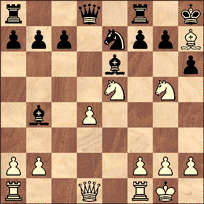
16 Qh5 Qxd4 17 Rad1 Qxb2 18 Bb1 Bxa2 19 Bxa2 Qxa2 20 Nexf7+ Kg8 21 Nxh6+ gxh6 22 Qxh6 Rf7 23 Nxf7 Qxf7 24 Rd4 Bc3 25 Rf4 Qh7 26 Qe6+ Kh8 27 Rf7 Qg6 28 Qxe7 Rg8 29 Qh4+ Resigns.
F.E. Greenaway – Adolf Anderssen
London, June 1851
Ruy López
1 e4 e5 2 Nf3 Nc6 3 Bb5 Nf6 4 O-O Nxe4 5 Re1 Nf6 6 d4 e4 7 Bg5 Be7 8 Bxf6 Bxf6 9 Rxe4+ Ne7 10 Nc3 c6 11 Bd3 d5 12 Rf4 Ng6 13 Bxg6 hxg6 14 Qd3 g5 15 Re1+ Kf8 16 Rxf6 gxf6 17 Ne2 Qd6 18 Ng3 g4 19 Nd2 f5 20 c4 f4 21 c5 Qh6 22 Ngf1 Be6 23 Qb3 Kg7 24 Qxb7 Rab8 25 Qc7 Rxb2 26 Qe7 Rxa2 27 Re5 Ra1 28 Rg5+ Kh7 29 h4 gxh3 30 Nf3 hxg2 31 Rxg2 Rg8 32 Ng5+ Kh8
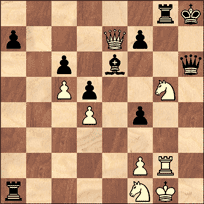
33 Rh2 Rxg5+ 34 Qxg5 Rxf1+ 35 Kxf1 Qxh2 36 White resigns.
Adolf Anderssen – Laroche
London, 28 May 1851
Sicilian Defence
1 e4 c5 2 Bc4 Nc6 3 Nc3 e6 4 d3 Nge7 5 Bf4 e5 6 Bg3 d6 7 f4 exf4 8 Bxf4 Ng6 9 Nge2 a6 10 O-O Be6 11 Bxe6 fxe6 12 Bg3 Be7 13 d4 cxd4 14 Nxd4 Qd7 15 Nce2 Nxd4 16 Qxd4 e5 17 Qc4 Bf6 18 Nc3 Rc8 19 Qb3 Ne7 20 Rad1 b5 21 a4 Nc6 22 Nd5 Nd4
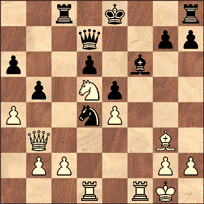
23 Rxd4 exd4 24 Rxf6 Resigns.
Adolf Anderssen – George Webb Medley
London, June 1851
Evans Gambit Accepted
1 e4 e5 2 Nf3 Nc6 3 Bc4 Bc5 4 b4 Bxb4 5 c3 Bc5 6 O-O d6 7 d4 exd4 8 cxd4 Bb6 9 h3 Nf6 10 Nc3 O-O 11 Bg5 h6 12 Bh4 Ne7 13 Bxf6 gxf6 14 Nh4 Kg7 15 Qh5 Ng6 16 Nf5+ Bxf5 17 exf5 Bxd4 18 Rac1 Ne5 19 Ne2 Bb6 20 Nf4 Nxc4 21 Ne6+ fxe6 22 Qg6+ Resigns.
Jules Arnous de Rivière – Adolf Anderssen
Paris, 1859
Rousseau Gambit
1 e4 e5 2 Nf3 Nc6 3 Bc4 f5 4 d4 d6 5 dxe5 fxe4 6 Qd5 Qe7 7 Bg5
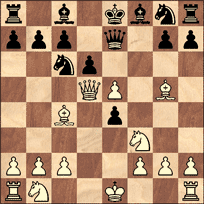
7...Be6 8 Qxe4 d5 9 Bxd5 Bxd5 10 Qxd5 Nf6 11 Bxf6 gxf6 12 O-O fxe5 13 Nc3 Qd6 14 Nb5 Qxd5 15 Nxc7+ Kd7 16 Nxd5 Bd6 17 Rad1 Raf8 18 Nd2 Kc8 19 c3 Bb8 20 b4 Rf7 21 b5 Nd8 22 Rfe1 Rhf8 23 f3 Rg7 24 Re4 b6 25 a4 Ne6 26 a5 Kb7 27 axb6 axb6 28 Rc4 Rd8 29 Ne4 Nf4 30 Nef6 Rxg2+ 31 Kh1 Rb2 32 Rg1 Nxd5 33 Nxd5 Rd7 34 Nf6

34...e4 35 Re1 Rxh2+ 36 Kg1 Rg7+ 37 Kf1 Rh1+ 38 Ke2 exf3+ 39 Kd2 Rg2+ 40 White resigns.
Adolf Anderssen – Serafino Dubois
London, 1862
King’s Gambit Accepted
1 e4 e5 2 f4 exf4 3 Nf3 g5 4 Bc4 Bg7 5 d4 d6 6 h4 h6 7 Qd3 g4 8 Ng1 Qf6 9 c3 h5 10 Na3 Bd7 11 Bd2 Ne7 12 O-O-O Nbc6 13 Ne2 Bh6 14 Rdf1 Ng6 15 Nc2 O-O-O 16 b4 Be6 17 Ba6 Nb8 18 Bb5 Ne5
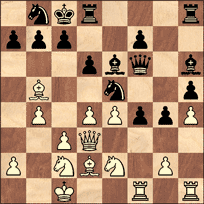
19 Qg3 f3 20 Nf4 fxg2 21 Nxg2 Bxd2+ 22 Kxd2 Nf3+ 23 Kc1 c5 24 Nge3 cxd4 25 cxd4 Nxd4 26 Rxf6 Resigns.
For none of the above games did Bachmann provide sources. If it proves possible to build up a list, we shall gladly present it in a future item.
We have obtained from the Cleveland Public Library a copy of the Adolf Roegner item. It comprises one folded cover page and one folded page inside, i.e.:
Front-cover (with the title Spielregeln für Nicht-Mitspieler)
Inside front-cover: blank
Title page: same as the front cover
Reverse of title-page: blank
Printed page (‘Halt’s Maul’)
Reverse of that page: blank
Inside back-cover: blank
Back-cover: list of items from Roegner’s chess business and a chess diagram.
Below are the cover page, text page and back-cover:
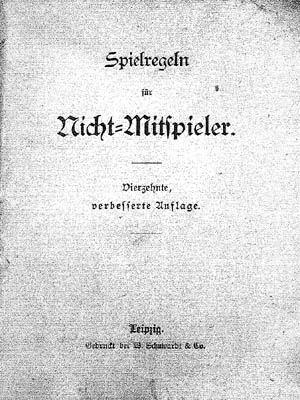
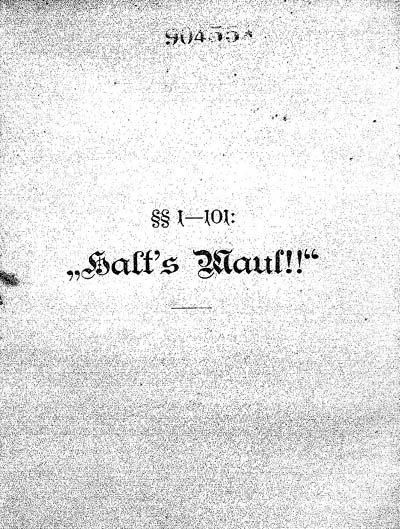
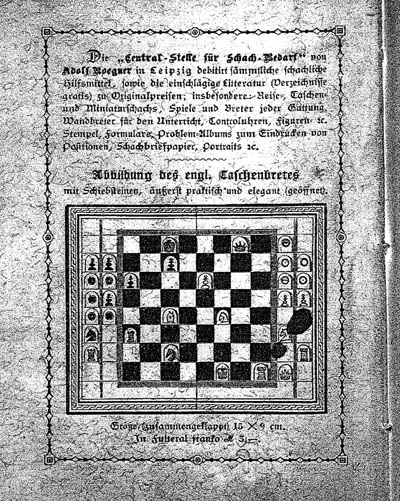
Under the title comes a reference reminiscent of Adolf Roegner’s remark in his light-hearted 1880 speech (C.N. 3356): ‘vierzehnte verbesserte Auflage’ (i.e. ‘14th revised edition’).
This, then, is the work which Reuben Fine described (in Bobby Fischer’s Conquest of the World’s Chess Championship, page 79) as consisting of ‘three hundred blank pages and one other page on which was written: KEEP QUIET’.
C.N. 3413 quoted from CHESS the remark, ‘He has the lamentable distinction of being – throughout the English-speaking world, anyway – the most under-estimated chess writer in the world.’
Now we reveal that these words appeared on page 230 of the April 1965 issue of CHESS and were a reference to Werner Lauterbach (1913-1989), who had just published a monograph on Mannheim, 1914.
Following the death of Huxley St John Brooks Chess World (1 January 1949, page 23) quoted from the South African Chess Magazine what C.J.S. Purdy described as ‘the best short humorous chess sketch ever written’. It is a seldom-seen genre, and we give the complete text below (proof-read with particular care):
‘“I am playing dam bad this evening”, remarked Mr Bronski, placing his reluctant King gracefully upon its side. “Once again I lose the Old Lady.”
“It is not so you are playing exactly bad, if you understand me”, replied his opponent. “Tonight I am playing too superior for you. Capablanca himself should be losing his Queen in such a wobbly position.”
“It would be because I play the Peasant to Bishop four?”
“That lose, of course.”
“But if I play my Peasant to Bishop three?”, Bronski rejoined with a note of hopeful interrogation.
“That also lose.”
“But if play der Horse and hit your Qveen?”, persisted Bronski.
“Then also I have a plan.”
Bronski sighed and proceeded to set up the pieces for another encounter.
“Chess is a very heavy game”, he said slowly. “If you play qvick you lose your Qveen, and if you doan’t play qvick the other fellow tink so strrong that also you are in trrouble.”’
An eminent figure with an interest in chess was the physicist Sir Oliver Lodge (1851-1940). From page 249 of his autobiography Past Years (London, 1931):
‘Sometimes we had a fit of chess. I once played the twentieth part of old Blackburn [sic], and once took part in a tournament [sic] against that inspired youth Capablanca.’
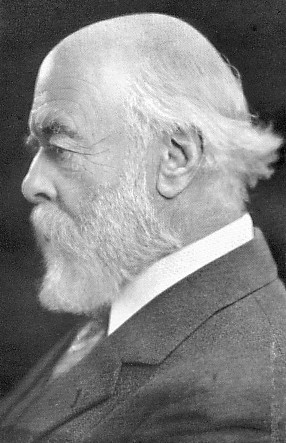
We are not aware that these games have been preserved and would welcome information about any mentions of the scientist in contemporary chess literature.
Searching for more information about the claims that Najdorf established a world record for simultaneous play in Bahía Blanca in the early 1940s, we have found a report in the May 1941 issue of the Argentinian magazine Enroque!! (ninth and tenth pages, but unnumbered). This states that on 19 April of that year (beginning at 14.30) Najdorf played 222 games at one and the same time and that when the séance ended (at about four o’clock the following morning) Najdorf had scored +202 –8 =12. Enroque!! also reported that the display was duly ratified by FIDE, via the Argentine Chess Federation, and gave one game:
Miguel Najdorf – Rodolfo M. Bentivoglio1 e4 e6 2 d4 d5 3 Nc3 Bb4 4 e5 c5 5 a3 cxd4 6 axb4 dxc3 7 bxc3
Qc7 8 Nf3 Qxc3+ 9 Bd2 Qc7 10 Bd3 Nc6 11 Qe2 b6 12 O-O Nge7 13 b5
Nd8 14 Bb4 Nb7 15 Nd4 Nc5 16 f4 Bd7 17 f5 g6 18 fxe6 Nxe6 19 Nxe6
Bxe6 20 Bd6 Qd7 21 c4 Rc8 22 cxd5 Bxd5 23 Be4 Bxe4 24 Qxe4 O-O 25
Qa4 Ra8 26 Qb4 Rfe8 27 Rad1 Qb7 28 Qc4 Nf5
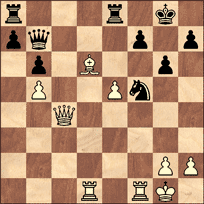
29 Rxf5 gxf5 30 Qf4 Re6 31 Qxf5 Rg6 32 Rd2 Rc8 33 h4 Rc1+ 34 Kh2 Qc8 35 Qf2 Qe6 36 h5 Rg5 37 Qf3 h6 38 Rf2 Rc4 39 g3 Rcg4 40 Qa8+ Kh7 41 Qf8 Rxh5+ 42 Kg2 Rf5 43 White resigns. The magazine pointed out that 42...Rxg3+ would have been a quicker finish.
Peter Anderberg (Harmstorf, Germany) writes:
‘The games played in London in 1851 were published in The British Chess Review, Volume I (1853), on pages 199, 199, 197, 81, 196, 79, 138 and 171, respectively. Arnous de Rivière v Anderssen is not really absent from von Gottschall’s monograph; compare game 288. It was published in the Illustrated London News, 26 March 1859. See also the Oxford Encyclopedia of Chess Games, page 280. With a slightly different ending (39 Kd1 Rgg1 0-1) the same game was published in La Nouvelle Régence, 1861 (according to the Oxford Encyclopedia, page 306), the Illustrated London News, 28 February 1863 and, finally, in Schachzeitung, April 1863, page 119. Obviously the Schachzeitung was von Gottschall’s source and the reason he misdated and misplaced the game (London 1862).’

J.R. Capablanca
Lecciones elementales de ajedrez
The most notable instance of the Cuban playing against blind opponents was his simultaneous display at Worcester College (United Kingdom) on 28 October 1919. A report in the Worcester Daily Times of the following day was quoted on pages 63-64 of the 2/1999 Quarterly for Chess History, and below is a photograph which accompanied a feature by W.H. Watts entitled ‘Worcester College for the Blind’ on pages 74-76 of Chess Pie No. 2 (1927):
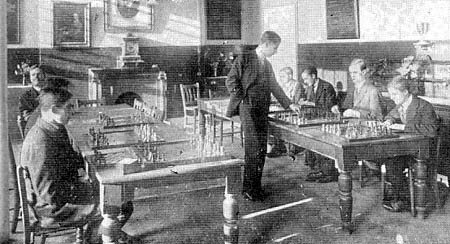
Chess Pie also published a photograph of Alekhine (fourth from the left) when he gave a simultaneous display at the College on 27 January 1926:

On pages 30-32 of the Social Chess Quarterly, January 1931 the then headmaster, G.C. Brown, discussed the school’s strong performance over the years (‘since the foundation of the Chess Club in 1913, of the 89 matches played against other public schools 85 have been won and one drawn’).
Some further jottings. The March 1884 BCM, page 110 had an item ‘Amusements for the Blind’ about the suitability and usefulness of chess. Similar ground was covered by Henry R. Hatherly on page 432 of the November 1889 BCM, with further discussion by Charles Tomlinson and William Wood on pages 483-484 of the December 1889 issue. Page 105 of the Chess Amateur, January 1907 reported: ‘Quite a feature of chess history is the fact that the Daily Mail edition for the blind includes a weekly chess problem in raised Braille character’, and more information about Braille publications, including a sample text, appeared on page 358 of the September 1907 Chess Amateur. In 1908 (April, page 162) and June (pages 242-244 – an article by T. Salthouse) the BCM covered other practicalities concerning chess for the blind. A future item will turn to a nineteenth-century blind player altogether forgotten today.
Wijnand Engelkes (Zeist, the Netherlands) refers to the large number of recorded games won by Louis Eichborn (1812-1882) against Adolf Anderssen and asks whether scores are available of Eichborn’s encounters with other players.
Eichborn v Anderssen is a topic that crops up from time to time; see, for instance, C.N.s 669 and 709, as well as pages 6-8 of Jaque, November 1995. As regards other games involving Eichborn, 15 or so were published by Deutsche Schachzeitung during his lifetime, and three of them are given below.
Louis Eichborn – Hillel
Breslau, January 1860
King’s Gambit Declined
1 e4 e5 2 f4 Bc5 3 Nf3 d6 4 c3 Bg4 5 Be2 Bxf3 6 Bxf3 Nc6 7 b4 Bb6 8 b5 Na5 9 d4 exd4 10 cxd4 Qf6 11 Be3 Nc4 12 Ke2 Nxe3 13 Kxe3
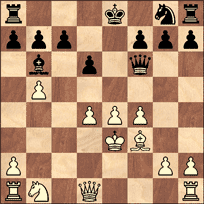
13...Ne7 14 Nc3 g5 15 fxg5 Qxg5+ 16 Kd3 c6 17 bxc6 Nxc6 18 Nd5 Bxd4 19 Rc1 Bb6 20 Nxb6 axb6 21 a4 b5 22 axb5 Qxb5+ 23 Ke3 Qb6+ 24 Kf4 Ne5 25 g4 Ra3 26 Rf1 Qe3+ 27 Kg3 Kd7 28 Qd5 Rb3 29 Rcd1 Rd3 30 Qxb7+ Ke6 31 Rxd3 Qxd3 32 Qd5+ Qxd5 33 exd5+ Ke7 34 h4 Rg8 35 Be2 Nxg4 36 Bxg4 h5 37 Rf4 Rxg4+ 38 Rxg4 hxg4 39 Kxg4 Kf6 40 h5 and wins.
Source: Deutsche Schachzeitung, January 1861, page 40.
Louis Eichborn – Nosa
Venue?, 22 November 1860
Queen’s Fianchetto Defence
1 e4 b6 2 d4 Bb7 3 Bd3 e6 4 Nf3 Ne7 5 c4 Ng6 6 a3 Be7 7 Nc3 O-O 8 Qc2 f6 9 g4 e5 10 Be3 c6 11 O-O-O a6 12 h4 b5 13 h5 Nf4 14 Bf1 b4 15 axb4 Bxb4 16 dxe5 fxe5 17 Nxe5 Qe7
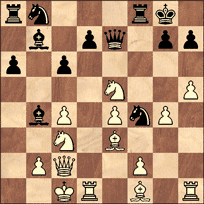
18 c5 Qxe5 19 Qb3+ Kh8 20 Qxb4 Bc8 21 h6 Ne6 22 hxg7+ Nxg7 23 Rd6 Rf6 24 f4 Qe7 25 Rd2 a5 26 Qa3 Ba6 27 Rdh2 Bxf1 28 Rxh7+ Kg8 29 Rh8+ Kf7 30 Rxf1 Qe6 (At this point another player, Friedländer, took over the white pieces.) 31 g5 Qc4 32 Re1 Re6 33 f5 Rxe4 34 g6+ Kf6 35 Bg5+ Kxg5 36 Rxe4 Qf1+ 37 Nd1 Nxf5 38 g7 Nxg7 39 Qg3+ Kf5 40 Qg4+ Kf6 41 Rf8 mate.
Source: Deutsche Schachzeitung, May 1866, pages 145-146.
Nosa – Louis Eichborn
Venue?, 10 September 1863
Giuoco Piano
1 e4 e5 2 Nf3 Nc6 3 Bc4 Bc5 4 c3 Nf6 5 O-O Qe7 6 d4 Bb6 7 d5 Nb8 8 Qd3 d6 9 Be3 O-O 10 Nbd2 h6 11 Bxb6 axb6 12 h3 Nh7 13 Nh2 f5 14 f3 f4 15 Ng4 Qg5 16 Nf2 Rf6 17 Kh1 Rg6 18 Rg1 Qh4 19 Qe2 Nf6 20 Nf1 Nh5 21 Qd2 Nd7 22 Ng4 Ng3+ 23 Nxg3 fxg3 24 Bf1 Nf8 25 Ne3 Rf6 26 a3 Ng6 27 Nf5 Rxf5 28 exf5 Bxf5 29 Re1 Rf8 30 Re4 Bxe4 31 fxe4
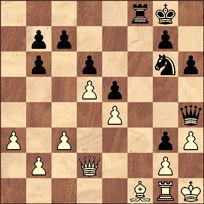
31...Rf2 32 Qd1 Qxh3+ 33 gxh3 Rh2 mate.
Source: Deutsche Schachzeitung, June 1866, page 173.

Who is this?
A brevity won by Amos Burn:
Mikhail Ivanovich Chigorin – Amos Burn
Ostend, 7 July 1905
King’s Gambit Declined
1 e4 e5 2 f4 Bc5 3 Nf3 d6 4 c3 Nf6 5 Bc4 Nc6 6 d3 O-O 7 Qe2 Re8 8 f5 d5 9 Bb3 Bxf5 10 Bg5 dxe4 11 dxe4 Bxe4 12 Qc4 Qd5
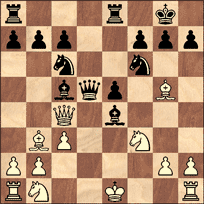
13 Qb5 Bf2+ 14 White resigns.
Chigorin’s 13 Qb5 allowed an immediate finish, and we note that an ‘improvement’ occurred recently in a game won by a Ukrainian prodigy:
Sergey Kalygin – Yuri Kuzubov
Alushta, 5 September 2004
King’s Gambit Declined
1 e4 e5 2 f4 Bc5 3 Nf3 d6 4 c3 Nf6 5 Bc4 Nc6 6 d3 O-O 7 Qe2 Re8 8 f5 d5 9 Bb3 Bxf5 10 Bg5 dxe4 11 dxe4 Bxe4 12 Qc4 Qd5 13 Qa4 Qd3 14 Nbd2 Bxf3 15 Nxf3 Ne4 16 Bh4 b5 17 Qa6 Nd4 18 Bd1 Nxf3+ 19 White resigns.
On page 35 of the 5/2004 New in Chess Boris Spassky commented during an interview:
Spassky would appear to be referring not to Capablanca’s ‘last will’ but to a letter he wrote to his son in Havana on 7 October 1925, i.e. when José Raúl junior was not yet three years old. On the other hand, we now note a mistake of our own, for in the English translation of the letter on page 135 of our Capablanca book some words (i.e. the reference to becoming a lawyer) have been lost. Our source for the Spanish original was pages 286-288 of the Cuban magazine Ajedrez Revista Mensual Ilustrada, June-July 1964, and below we give a complete translation:‘Capa was an aristocrat. Just take his last will. I was reading from his last will here, because these days people are quite ignorant. First of all he asked his son to be a lawyer, to protect the property. Secondly he said that he should be a very good swimmer and a very good boxer, just to be very confident on the land and on the sea (starts laughing). But most of all he asked his son to love his mother.’
‘Union Club, Havana, 7 October 1925
My dearest son,
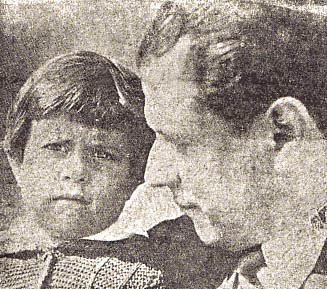
You must keep this letter to read it again when you are 21 because things that you do not know and understand now you will know and understand then. First of all, you must always respect and love your mother above all else. Try never to tell her lies; always tell her the truth. Your father, writing these lines, has a reputation throughout the whole world for being a very honest man – very truthful and honourable. Try to imitate me in all this. Be studious and strong so that you can defend your mother and your sister with your head as well as with your hands. Whatever wishes you may have to study a particular thing, remember that in any case you must become a lawyer before anything else, so that you can defend your own interests and those of your family. After you have become a lawyer you can, if you prefer something else, concentrate on whatever you like. Don’t forget that the best period of a man’s life is when he is a student. As a boy this will not seem so to you, but when you have gone through that stage and reached the age of 40 you will see the truth of what I am telling you. On the physical side, there are two things you must know how to do well – swim and box, so that you can defend yourself at sea as well as on land. This does not mean that you should often fight, but that you must be prepared to do so if necessary.
Try to be a man of wide culture. There is nothing in the world as entertaining as books. It is also necessary to be useful to humanity. If you can avoid it, never play cards, smoke or drink alcohol of any kind. These are bad habits which greatly shorten life and weaken men physically as well as intellectually and morally.
Be an honest and good man.
Your father embraces you with all his love.
J.R. Capablanca.’
 |
The envelope was marked as follows: ‘For my son José Raúl |
For a photographic reproduction of part of the letter, as well as a German translation of the full text, see pages 124-125 of Das Schachgenie Capablanca by I. and W. Linder (Berlin, 1988). Capablanca wrote the letter shortly before leaving for Europe and the Moscow, 1925 tournament.
‘The blind chessplayer, Mr Lumley, has just arrived in London, and played, at the Philidorian Chess Rooms, three games at the same time. This blindfold performance is the more extraordinary as this young man, being blind for several years, and having only learnt chess since he became blind, has had, therefore, no opportunity of studying the game from books.’
Two further scores, against Zytogorski and Kenny, were published that year on pages 297-299, and in 1861 (page 110) the Chronicle quoted from the Wellingborough News a report which concluded:
‘The extraordinary play of Mr Lumley elicited the highest admiration, whilst his unassuming manners and his heavy affliction caused the utmost sympathy to be felt for him.’
A win by ‘Mr G. Lumbley’ in Cambridge appeared on page 138 of the 1861 Chronicle, but only one of the games ever given by the magazine, a loss, seems striking enough to be reproduced here:
G. Lum(b)ley – Kenny
London, September 1859
Ponziani Opening
1 e4 e5 2 Nf3 Nc6 3 c3 f5 4 Bb5 fxe4 5 Bxc6 exf3 6 Bxf3 Nf6 7 d3 d5 8 Bg5 c6 9 O-O Be7 10 Re1 Qc7 11 Qe2 Bd6 12 h3 O-O 13 Nd2 Bf5 14 Qe3 Rae8 15 Bxf6 Rxf6 16 Nb3 Qf7 17 Rad1

17...Bxh3 18 Bxd5 cxd5 19 Qxh3 Rxf2 20 Nd2 Rf6 21 Qe3 Qh5 22 Nf3 e4 23 dxe4 dxe4 24 Rxd6 Rxd6 25 Ng5 Rd1 26 Nf3 exf3 27 Qxe8+ Qxe8 28 White resigns.
From a slightly later period a young blind player about whom more is known was Oscar Bilgram. See pages 25-28 of Essays in American Chess History by John Hilbert (Yorklyn, 2002).
Peter Anderberg (Harmstorf, Germany) mentions that a decade or so after Louis Eichborn’s death some further games and biographical information were given in the Deutsche Schachzeitung (March 1893, pages 65-73). We pick the following game:
Eliason – Louis Eichborn
Breslau, 10 August 1859
Two Knights’ Defence
1 e4 e5 2 Nf3 Nc6 3 Bc4 Nf6 4 Ng5 d5 5 exd5 Na5 6 Bb5+ c6 7 dxc6 bxc6 8 Ba4 h6 9 Nf3 e4 10 Ne5 Qd4 11 Bxc6+ Nxc6 12 Nxc6 Qc5 13 Nxa7 Qxa7
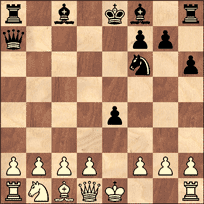
(A rare instance of a player’s queen’s-side pawns having all gone by move 13.) 14 O-O Bc5 15 Qe1 O-O 16 Nc3 Ba6 17 Ne2 Qd7 18 h3 Nh5 19 Kh2 Qb5 20 d3 exd3 21 Nc3 Qb8+ 22 Kh1 dxc2 23 Rg1 Bxf2 24 Qxf2 Ng3+ 25 Kh2 Nf1+ 26 Kh1 Qh2 mate.
Christian Sánchez (Rosario, Argentina) has sent us a letter written by Capablanca which was presented (and billed as previously unpublished) on page 25 of Magazine Actual, May 1997. Below are the original and our English translation:
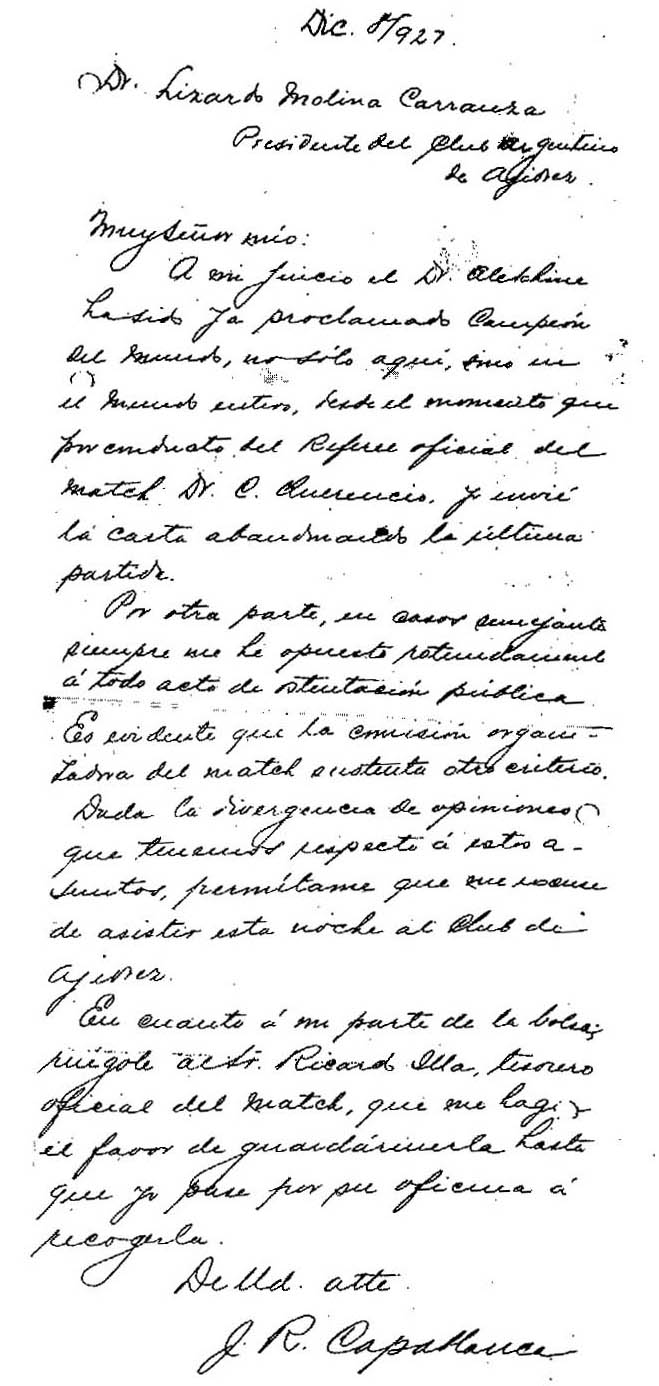
‘8 December 1927
President of the Club Argentino de Ajedrez
Dr Lizardo Molina CarranzaDear Sir,
In my opinion, Dr Alekhine was already proclaimed world champion, not only here but throughout the entire world, from the moment when, through the official match referee, Dr C. Querencio, I sent the letter in which I resigned the final game.
Moreover, in similar cases I have always emphatically opposed any act of public ostentation. It is clear that the organizing committee of the match is applying a different criterion.
Given our difference of views with respect to these matters, permit me to refrain from attending tonight at the Chess Club.
As regards my share of the purse, I am asking Mr Ricardo Illa, the official match treasurer, kindly to retain it for me until I go to his office to collect it.
Yours sincerely,
J.R. Capablanca.’
The context is that on 29 November 1927 Capablanca had written to Alekhine (in French) to resign the 34th and last match game, adding ‘you are therefore the world champion’. The day the above-quoted letter was written to Lizardo Molina Carranza (8 December 1927) Alekhine was ‘officially proclaimed world champion’ at the Club Argentino de Ajedrez, as reported on page 123 of the January 1928 issue of El Ajedrez Americano. After an address by Carranza on the significance of the match, Alekhine spoke, thanking the Club for its work and declaring himself against changes to the world title match rules.
A photograph of the ceremony appeared on page 166 of Match por el título mundial (Buenos Aires, 1978). On the far right is Lizardo Molina Carranza, with Alekhine standing on his right. Ricardo Illa is seated, his hands clasped.

Continuing with the Capablanca flavour of several recent C.N.
items, we give below a position from a game he won against C.P.
Dutt in a simultaneous display (+39 –0 =1) in Bristol on 9 October
1920. It was published on page 7 of the Western Daily Press
of 11 October 1920.
|
26...f6 27 Kd3 b4 28 Bd4 Bd6 29 g3 Kf7 30 Bb6 Ke6 31 Kd4 Be5+ 32 Kc5 Bd6+ 33 Kc6 g5 34 Bc5 Bxc5 35 Kxc5 Ke5 36 Kxb4 Kd4 37 a4 Ke3 38 a5 d4 39 a6 d3 40 a7 d2 41 a8(Q) d1(Q) 42 Qe4+ Kf2 43 f4 Qd6+ 44 Kc4 Qa6+ 45 Kc5 Qa5+ 46 Kd6 Qb6+ 47 Ke7 Qxb3 48 Kxf6 gxf4 49 gxf4 Qc3+ 50 Qe5 Qc6+ 51 Qe6 Qc3+ 52 Kg5 Qg7+ 53 Kf5 Qf8+ 54 Qf6 Qc5+ 55 Kg4 h5+ 56 Kh4 Kf3 57 Qg5 Qf2+ (The newspaper did not mention the much stronger move 57...Qd6.) 58 Qg3+ Qxg3+ 59 hxg3 Resigns. |
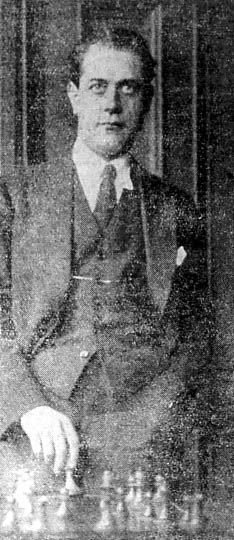 |
The photograph was of Olga Capablanca Clark. She sent it to us in the 1980s, writing on the reverse: ‘as one of [the] Renaissance queens in a pageant. Early thirties.’
C.N. 3249 raised the question of whether the game 1 e4 c5 2 Nf3 d6 3 Nc3 e5 4 Bc4 Nc6 5 d3 Nge7 6 Bg5 Bg4 7 Nd5 Nd4 8 Nxe5 Bxd1 9 Nf6+ gxf6 10 Bxf7 mate was played by H.T. Buckle (in 1840) or by R.J. Buckley (many decades later). Does any reader know when the apparent confusion between the names Buckle and Buckley arose?
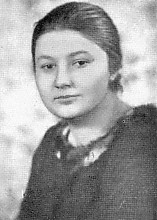 Chess writers seldom compose more than a few lines about Vera
Menchik without mentioning that male players defeated by her
became, ipso facto, members of the Vera Menchik Club,
but what is known for sure about the origins of this cardinal
component of chess lore?
Chess writers seldom compose more than a few lines about Vera
Menchik without mentioning that male players defeated by her
became, ipso facto, members of the Vera Menchik Club,
but what is known for sure about the origins of this cardinal
component of chess lore?
The passage below is from page 313 of The Encyclopaedia of Chess by A. Sunnucks (London, 1976):
‘The following year [1929] she played in Paris and Carlsbad, and it was at Carlsbad that the famous Menchik Club was formed. The invitation to Vera Menchik to compete among such players as Capablanca, Euwe, Tartakower and Nimzowitsch was received with amusement by many of the masters. The Viennese master Becker was particularly scornful, and in the presence of a number of the competitors he suggested that anyone who lost to Vera Menchik should be granted membership of the Menchik Club. He himself became the first member. Other famous players who later joined the club were Euwe, Reshevsky, Sultan Khan, Sir George Thomas, C.H.O’D. Alexander, Colle and Yates.’
At Carlsbad, 1929 Vera Menchik finished last with a score of +2 –17 =2. On page 64 of the 4/1980 Boletín Ajedrez Radio Rebelde José Luis Barreras purported to quote the exact words of an announcement by Albert Becker:
‘When the tournament is over, I propose to open the Vera Menchik Club, whose members will be solely masters defeated by the lady world champion.’
We have yet to find any such reference in 1929 sources, although on page 19 of the Carlsbad, 1929 tournament book Hans Kmoch wrote:
‘Bange Sorgen bereitete sie dem Wiener Meister, der sich vor dem Turnier verpflichtet hatte, fortan als Ballettmädel aufzutreten, falls Fräulein Menschik mehr als 3 Punkte erzielt. Er hat sein Gelübde längst bitter bereut und wird solches nie mehr tun. Seinen Namen will ich diskreterweise verschweigen, ich verrate nur, dass er auf “Hans” getauft ist, sich anfangs mit “K” und zu Ende mit “ch” schreibt.’ (English translation: ‘She caused fearful anxiety to the Viennese master who, before the tournament, undertook thenceforward to go on stage as a ballerina if Miss Menchik scored more than three points. He has long since bitterly repented his vow and will never again act in such a way. I shall discreetly conceal his name, disclosing only that he was baptized “Hans” and that his surname begins with a “K” and ends with “ch”.’)
By the early 1930s the Club was becoming a familiar piece of whimsy. For example, the following appeared in a report about Hastings, 1930-31 on page 54 of the February 1931 BCM:
‘Sir George Thomas once again lost to Miss Menchik and is now acclaimed as president of the “Menchik Club” – the membership of which is strictly limited to victims of the woman champion.’
Tartakower (a participant in Carlsbad, 1929) wrote a few lines
about the Menchik Club on page 70 of Neue Schachsterne
(Vienna, 1935), but without indicating who had originated it.
Morgan Daniels (London) asks for information about the unusual picture:
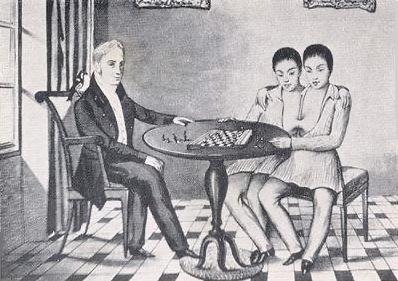
Mr Daniels also mentions that a frequent entry in old editions of the Guinness Book of Records concerned a chess game, begun in the 1920s and continued for decades, in which the players, Grant and MacLennan, played a move each Christmas.
We are not aware that the game-score has ever been published, but perhaps a reader will be able to provide information. In the meantime, we note two other cases of lengthy postal games:
Firstly, a paragraph from page 215 of CHESS, 17 May 1957:
‘H. Jarvis, Croydon, played postal chess from 1931 (when he went on holiday to Germany) onwards, with Eberhardt Wilhelm, secretary of the international correspondence chess organization. When the war started, it was Mr Jarvis to move. Naturally the game was abruptly interrupted, and after the war ended it was two years before normal postal services were resumed. Wilhelm thereupon wrote and pointed out that it had been Mr Jarvis’ move for eight years and said that if he did not reply by return he would claim the game. Mr Jarvis had the move ready; he despatched a move at once and the games were duly concluded. So the one move took eight years. “Is this a record” asks Mr Jarvis “for the longest time ever taken to play a chess move?”’
Secondly, a game which took about 16 years and was widely published in the mid-1870s:
Karl Brenzinger – Francis Eugene Brenzinger
Correspondence, 1859 – 18 March 1875
Two Knights’ Defence
1 e4 e5 2 Nf3 Nc6 3 Bc4 Nf6 4 Ng5 d5 5 exd5 Na5 6 Qe2 Nxc4 7 Qxc4 Bd6 8 d3 O-O 9 Nc3 h6 10 Nge4 Kh8 11 O-O Nh5 12 d4 f5 13 Nxd6 cxd6 14 dxe5 dxe5 15 Qe2 Qe8 16 Nb5 f4 17 f3 Ng3 18 hxg3 fxg3 19 f4 Bd7 20 Nd6 Qe7 21 Ne4 Qh4 22 Nxg3 Qxg3 23 Rf3 Bg4 24 Rxg3 Bxe2 25 Re3 Bc4 26 d6 Rxf4 27 Re1 Rd4 28 b3 Bb5 29 c4 Bc6 30 c5 Rg4 31 Re2 Rf8 32 Be3 Kg8 33 a4 Rb4 34 Rb2 Kf7 35 Bd2 Rg4 36 Bc3 Ke6 37 b4 Rf3

38 Bxe5 Kxe5 39 b5 Be4 40 Rd2 Rfg3 41 Raa2 Bxg2 42 d7 Bc6+ 43 Kh2 Bxd7 44 Rxd7 Rg6 45 Re2+ Kf6 46 Rde7 (This mistake was attributed to impatience after Black took seven months over his 45th move.) 46...Rg2+ 47 Rxg2 Rxg2+ 48 Kxg2 Kxe7 49 Kf3 h5 50 a5 Kd7 51 White resigns.
Sources: La Stratégie, 15 May 1875, pages 141-143, and Deutsche Schachzeitung, July 1875, pages 218-219.
Although the magazines specified that White and Black lived in Pforzheim and New York respectively, Irving Chernev (on page 129 of his book Wonders and Curiosities of Chess) stated that the game was ‘between a Mr Brenzinger of New York and his brother in England’.
‘The reports in the newspapers La Nación and La Prensa of Buenos Aires and La Capital of Rosario broadly agree with the magazine Enroque!! regarding Najdorf’s record, as given in C.N. 3419. The display was held at the Club Atlético Olimpo of Bahía Blanca and attracted 5,000 spectators. It began at 14.30 and ended at 04.00 the next day. However, the reports indicate irrefutably that the day the exhibition began was 1 May 1941. That Enroque!! put 19 April is doubtless an error resulting from the similarity between “19” and “1º” (the latter meaning “first” in Spanish).’
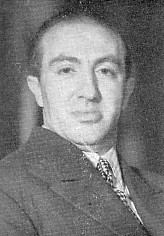
Miguel Najdorf
Our correspondent has kindly submitted transcriptions of the following reports:
C.N. 3398 discussed the various spellings of Alexander McDonnell’s surname, i.e. McDonnell, M’Donnell and MacDonnell (with, furthermore, the c sometimes in superscript and a full stop occasionally added below such a raised c). The item traced how research in the 1940s and 1950s resulted in McDonnell becoming the ‘accepted’ spelling.
From David McAlister (Hillsborough, Northern Ireland):
‘Since I was first able to spell my name (in the 1950s) I have considered M plus a small c (Mc) to be interchangeable with M plus an apostrophe (M’). A friend who has an excellent knowledge of the Ulster Scots heritage has confirmed that until probably about 50 years ago M’ was frequently used (particularly in print) to represent Mc. My cuttings of Belfast News-Letter chess columns from the 1930s to the 1950s suggest that it was the standard rendition. Today, M’ has fallen out of use.
When I sign my name the small c is aligned with the top of the other letters, so that it actually looks quite like an apostrophe. I would therefore suggest that McDonnell and M’Donnell are in reality the same. MacDonnell, however, is a true variation in spelling.
The other issue is the full stop under the small c. Having checked this with my expert friend, I think that the full stop is decorative in nature or emphasizes the fact that the small c should appear at the top of the line of characters.’
John Hilbert (Amherst, NY, USA) sends Steinitz’s notes to the game in C.N. 3435, from The Field, 24 April 1875:
‘Dr Brenzinger – F. Eugene Brenzinger
Correspondence game, 1875We derive from the Turf, Field, and Farm, of New York, the moves of the ensuing game, which was played by correspondence between Dr Karl Brenzinger, of Pforzheim, Baden, and Mr F.E. Brenzinger, of New York. It is probably the longest game, in point of time taken for its progress, that has ever been played; for, according to the statement of the above quoted paper, it was commenced as far back as 1859, and was only brought to a conclusion on 18 March 1875, its duration having extended over 16 years. 1 e4 e5 2 Nf3 Nc6 3 Bc4 Nf6 4 Ng5 d5 5 exd5 Na5 6 Qe2 (An unusual continuation, and no better for its originality. Black can now recover the pawn, with at least an even game. Mr Zukertort recommends here 6 Bb5+, as even sounder than Morphy’s favorite move, 6 d3.) 6...Nxc4 7 Qxc4 Bd6 (Black’s refusal to recover the pawn cannot be regarded as safe, though it leads to lively and interesting complications. We believe his surest plan to have been to capture the d-pawn with the queen, followed by ...Bd6, in case the queen took the c-pawn, and, if White exchanged queens at once, his knight would have been out of play.) 8 d3 O-O 9 Nc3 h6 10 Nge4 Kh8 11 O-O Nh5 12 d4 f5 13 Nxd6 cxd6 14 dxe5 dxe5 15 Qe2 Qe8 16 Nb5 f4 (A very fine conception, which frustrates White’s contemplated attack.) 17 f3 (Best. Black’s answer to 17 Nc7 would have been ...Qg6, threatening the destructive assault of ...f3, and the game might have gone thus: 17 Nc7 Qg6 18 Qxe5 Bh3 19 g3 Rae8 20 Nxe8 Rxe8 21 Qc3 Qe4 22 f3 Qe2 and wins.) 17...Ng3 (A bold measure, which it was rather difficult to counteract; but we think that, with the best play, the opponent ought to have been able to turn the game in his favour.) 18 hxg3 fxg3 19 f4 (The only move. 19 Be3 would have been of no use, e.g.: 19 Be3 Qh5 20 Rfe1 Bg4 21 queen moves Qh2+ 22 Kf1 Bxf3 and must win.) 19...Bd7 20 Nd6 (This manoeuvre was by no means a bad recourse, and was evidently adopted with the intention of returning the piece gained for the troublesome pawn at g3, and afterwards relying upon the numerical superiority of pawns. But it strikes us that the success of this plan, though it secured a draw, was made very doubtful, as far as winning was concerned, by the circumstance of the bishops being of opposite colour; while another modus operandi might, in our opinion, also have provided for Black an escape from the dilemma, and, at the same time, retained for him a much better chance of ultimate victory. Of course, Nc7 would have still been bad, on account of Black’s reply, ...Qg6, and also to win the knight by ...Qb6+; but, supposing White retreated the knight to c3, we see no stronger continuation for Black than the following: 20 Nc3 Qg6 21 f5 Bxf5 [has he anything better?] 22 Qe3, followed by Ne2, and we believe that Black has not sufficient for the piece sacrificed.) 20...Qe7 21 Ne4 Qh4 22 Nxg3 Qxg3 23 Rf3 Bg4 24 Rxg3 Bxe2 25.Re3 (25 fxe5 appears more plausible; though against the best play it would have scarcely effected more than a draw; for instance: 25...Rf1+ 26 Kh2 Bc4 27 d6 Be6 28 b3 Rc8 29 c4 b5, etc.) 25...Bc4 26 d6 Rxf4 27 Re1 Rd4 28 b3 Bb5 29 c4 Bc6 30 c5 Rg4 31 Re2 Rf8 32 Be3 Kg8 33 a4 Rb4 34 Rb2 Kf7 (All this is nicely played by Black.) 35 Bd2 Rg4 36 Bc3 Ke6 37 b4 Rf3 38 Bxe5 (Had White protected the bishop by Rc2, the game might have proceeded thus: 38 Rc2 Be4 39 Rd2 Rxc3 40 d7 Rxg2+ 41 Rxg2 Kxd7, etc.) 38...Kxe5 39 b5 Be4 40 Rd2 Rfg3 41 Raa2 Bxg2 42 d7 (Our American contemporary here justly remarks that White could have easily drawn the game by now exchanging all the pieces, followed by a5, but that Dr Brenzinger probably, and not without reason, played to win.) 42...Bc6+ 43 Kh2 Bxd7 44 Rxd7 Rg6 45 Re2+ Kf6 46 Rde7 (A gross blunder, which makes the termination quite unworthy of the longest-lasting game on record. Our American contemporary ascribes this sudden collapse to a feeling of impatience on the part of Dr Brenzinger, caused by his opponent having taken seven months before answering the last move.) 46...Rg2+ 47 Rxg2 Rxg2+ 48 Kxg2 Kxe7 49 Kf3 h5 50 a5 Kd7 51 White resigns.’
|
John Hilbert has also forwarded us a photocopy, obtained from the Cleveland Public Library, of the handwritten text ‘An analysis, by John Keeble, of the Lewis Rou MS’ which set out J.K.’s reasons for believing that Daniel W. Fiske had perpetrated a hoax regarding the alleged eighteenth-century document. Perhaps an enterprising publisher could, with the Library’s permission, bring out a small edition of Keeble’s text, not least because it would be difficult to summarize his various arguments here. The Library holds, moreover, a copy of a letter to Keeble dated 27 March 1926 from John G. White, who expressed the view that Fiske had a penchant for hoaxes:
What is, in fact, known about (other) hoaxes allegedly perpetrated by Fiske? |
|
|
Below is an extract from an article by D.W. Fiske entitled ‘Newspaper errors’ which was published in the Syracuse Journal of 22 June 1865 and reprinted on pages 226-228 of Memorials of Willard Fiske by H.S. White (Boston, 1920):
|
|
From page 113 of Jubileum Uitgave van de Soerabajasche Schaakclub by W.N. Dinger (Soerabaja, 1936) we reproduce a photograph of Alekhine (in centre) at a 43-board simultaneous display in Soerabaja on 4 March 1933:
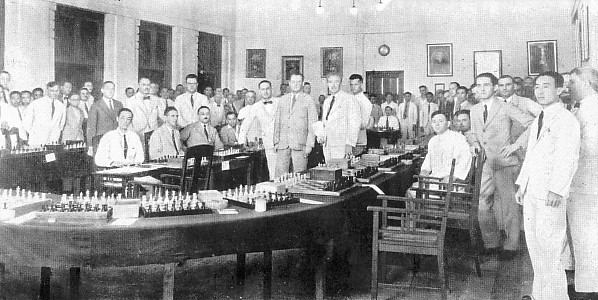
If any reader has information about the position being studied by Capablanca in this photograph we shall be grateful to know.
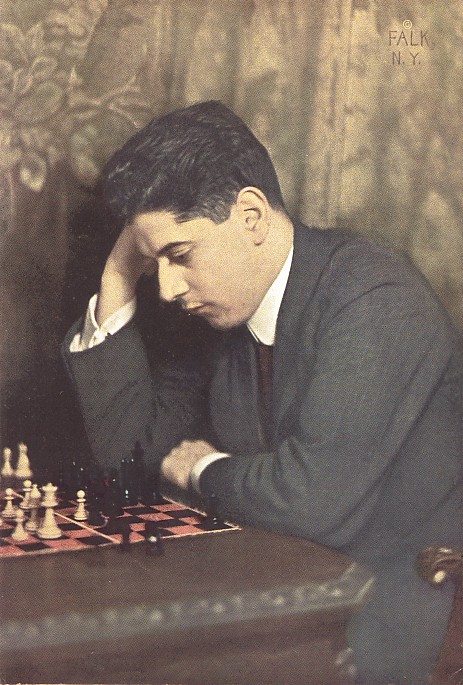
Owen Hindle (Cromer, England) has sent us an 11-page typescript on G. Lum(b)ley, about whom it has not yet been possible to establish even the basic biographical details. Mr Hindle has, however, found a number of further reports in contemporary sources, such as the following in The Norfolk News of 26 March 1859:
‘Mr Lumbley is a young man, who has been totally blind for ten years, and knew nothing of chess till two and a half years ago, so that his great skill in playing the game is little short of marvellous. We are sorry to add that he is in very needy circumstances...’
The same newspaper (14 January 1860) reported that in Norwich he had just played four games simultaneously (+2 –1 =1), whereas The Field of 20 July 1861 announced that in Hull he had played eight games at once, winning five of them. On the other hand, he lost a match to G.B. Fraser +0 –7 =0 (Dundee Courier and Argus, 31 August 1863).
Finally, Mr Hindle notes that on page 21 of the 1893 publication Liverpool Chess Club two further complications are added (i.e. a companion blind player and another spelling in addition to Lumley and Lumbley):
‘In 1858 Harrwitz visited the Club, as also did the two blind boy players.’
‘In 1860 Kolisch and the blind boy player Lumby were visitors.’
From page 242 of Chess World, November 1952, the writer being C.J.S. Purdy:
‘Sarapu thinks nothing of playing lightning chess at five seconds a move – his opponent seeing the board. Besides Sarapu, Reuben Fine and George Koltanowski are the only players I have heard of who play lightning chess blindfold, but as far as I know they have only played at ten seconds. Dawdlers!’
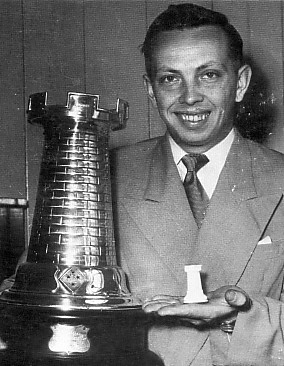
Ortvin Sarapu
It may be recalled that in C.N. 3047 Christian Sánchez (Rosario, Argentina) reported that Franz/Francisco Benkö participated in his first Argentine championship in 1938, coming 20th, and that at the age of 92 he took part in the 2002 national championship (finishing 38th). Our correspondent now informs us:
‘Francisco Benkö (aged 94) has just taken part in the 2004 Argentine Championship, finishing 91st. His record of competition therefore now spans 66 years. To qualify for the 2002 event he had to win in the last round of the Metropolitan Championship.’
Mr Sánchez has provided that decisive game from the event, as well as a photograph of Benkö:
Francisco Benkö – Guillermo Ligato
Metropolitan Championship, Buenos Aires, 8 July 2002
Alekhine’s Defence
1 e4 Nf6 2 Nc3 d5 3 exd5 Nxd5 4 Bc4 e6 5 d4 Nxc3 6 bxc3 Nd7 7 Nf3 Be7 8 O-O O-O 9 Re1 c6 10 Bf4 Nb6 11 Bd3 Nd5 12 Bd2 Qc7 13 Ne5 Nf6 14 Qf3 Bd6 15 Qh3 g6 16 Bh6 Re8 17 Qh4 Nh5 18 Re3 Be7
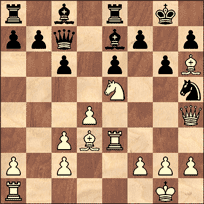
19 Qxh5 gxh5 20 Rg3+ Bg5 21 Rxg5+ Kh8 22 Bg7+ Kg8 23 Bf6+ Kf8 24 Bxh7 Resigns.
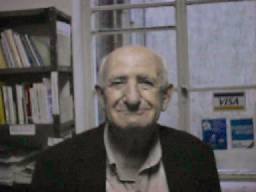
Francisco Benkö
No reader has yet provided information about the picture of Philidor in C.N. 3431, but Michael Clapham (Ipswich, England) sends us an advertising sheet (‘M. & N. Hanhart IMPT’) which he found in a copy of The Chess Player’s Chronicle. The portrait of Philidor is well known, but can a reader provide details about ‘the Philidor chess men’?
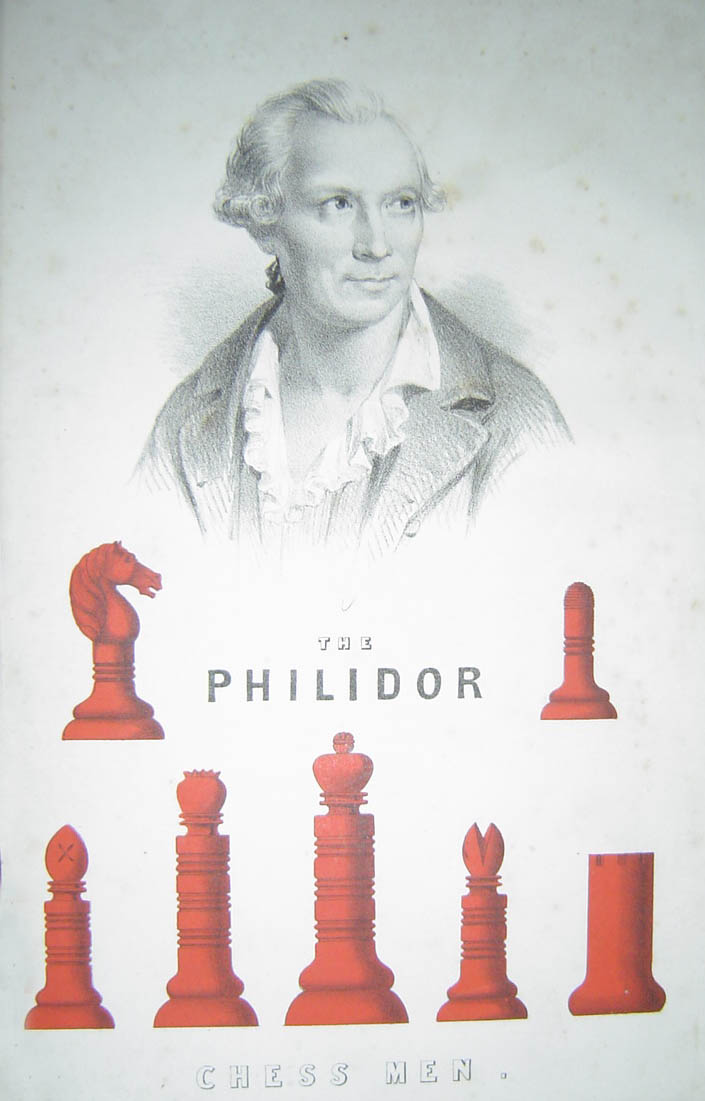
From Brad Dassat (Oldham, England):
‘The position being studied by Capablanca appears to be from the game Karel Hromádka v Rudolf Spielmann, Pistyan, 1912, at White’s 18th move.’
Karel Hromádka – Rudolf Spielmann
Pistyan, 28 May 1912
Vienna Game
1 e4 e5 2 Nc3 Nf6 3 f4 d5 4 fxe5 Nxe4 5 Qf3 f5 6 d3 Nxc3 7 bxc3 d4 8 Qg3 Nc6 9 Be2 Be6 10 Bf3 Qd7 11 Rb1 Bc5 12 Rb5 Bb6 13 c4 a6 14 Rb1 O-O-O 15 Ne2 h6 16 h4 g5 17 hxg5 hxg5 18 Rf1 Ba5+ 19 Bd2 Bxd2+ 20 Kxd2 g4 21 Bxc6 Qxc6 22 Nf4 Bf7 23 Rfe1 Rhe8 24 Re2 Re7 25 Rbe1 Qa4 26 e6 Qxa2 27 exf7 Qa5+ Drawn.
Since the group photograph from this tournament is relatively little known, we reproduce it below.
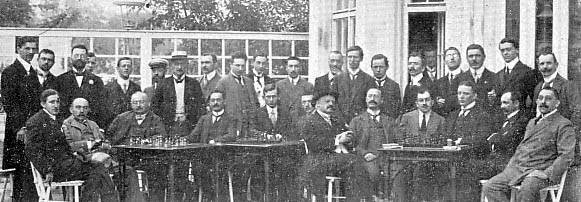
Claes Løfgren (Randers, Denmark) points out that a colour version of the alleged Philidor picture appeared on page 79 of The World of Chess by A. Saidy and N. Lessing (New York, 1974). Page 248 stated that it came from the Cleveland Public Library.
CHESS, 14 January 1938, page 155 featured two photographs of Frank Marshall in play against Kurt Lüdecke, with the following explanation:
‘Frank Marshall and Kurt G.W. Lüdecke started a game on 31 July 1914, the photograph on the left being taken in the course of the game. The War broke out and Marshall had to make an expeditious getaway to Holland, England and home. On 1 December 1937 the game was resumed and concluded. In the meantime Marshall had held the US Championship for some two decades and his opponent had written the sensational book I Knew Hitler, published last year.’
C.N. 2793 quoted from page v of Tal-Botvinnik II Match (published by Alfred Kalnajs & Son, Chicago, 1969 – no author specified):
‘The former world chess champion Dr A. Alekhine, playing in a simultaneous exhibiton [sic] at Riga, 1937 [sic] – a year before [sic] Tal’s birth – could score only 17 wins out of 50 games. “Riga is a main stronghold of European chess”, said Alekhine after his failure.’
We noted that Alekhine gave a number of displays in Riga in September 1935 (see page 780 of the Skinner/Verhoeven book on Alekhine) but that information was unavailable about a 50-game exhibition.
No further details have come to light, but we can add that the identical passage appeared on page 15 of the same publisher’s book The Chess Psychologist World Champion Tal by A. Liepnieks (1961 and 1975 editions).
A sketch of James A. Leonard (1841-62) was included in Kings, Commoners and Knaves, and C.N. 3020 mentioned that a second picture of him appeared (in minuscule form) in Chess Amateur page headings (e.g. on page 150 of the March 1914 issue):
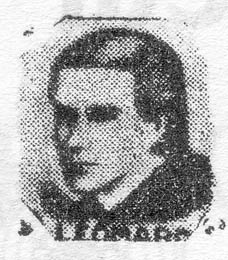
Where can a better copy of this portrait be found?
It would seem to be part of a substantial series of pictures from an undetermined source. For instance, page 7 of the October, 1912 Chess Amateur showed Rev. C.E. Ranken wearing a mortarboard, while the following portrait of Howard Staunton was given on page 394 of the October 1911 issue:
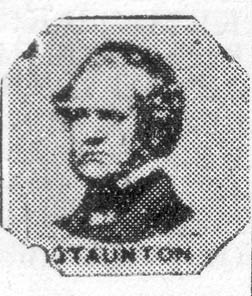
Giordano Bergamo (Cavareno, Italy) quotes the dedication on page 5 of Ultime lezioni by J.R. Capablanca (Milan, 1974), i.e. the second Italian edition of the ‘Last Lectures’ book:
‘Al signor Ferrantes, unico editore europeo che, per la pubblicazione di queste conversazioni, si sia ricordato degli eredi di Capablanca. Con grande stima.
Olga Capablanca
New York, aprile 1949.’
(Translation: ‘To Mr Ferrantes, the only European publisher who, in publishing these conversations, has remembered Capablanca’s heirs. With great esteem.’)
The 1950 and 1974 editions of Ultime lezioni were both published by L’Italia scacchistica. As our correspondent points out, the magazine was edited by the late Giovanni Ferrantes from 1946 until 1992.
It is unclear to us what lay behind Olga Capablanca’s remark. Our collection also contains editions of the ‘lectures’ in various other languages (Spanish, English, German, Portuguese, Russian and Estonian) but none of them was published before 1950.
A rather different version of the Marshall v Lüdecke story was given on page 114 of the November-December 1937 American Chess Bulletin:
‘A game begun by Frank J. Marshall and Kurt G.W. Lüdecke, author of I Knew Hitler, at Mannheim two days before the world war broke out, was reproduced from a photograph when they met again the other day, after 23 years, at the Hotel Shelton in New York. Failing to recall whose move it was, they did not finish it. Instead they contested three rapid transit games, Marshall winning two and drawing one.’
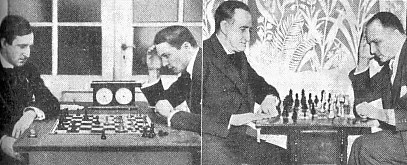
I Knew Hitler was subtitled ‘The Story of a Nazi Who Escaped The Blood Purge’. On pages 29-30 of the London, 1938 edition Lüdecke wrote:
‘One reason I think I was never a gambler at heart is that I can lay claim to the quality of patience – even the profound patience required of a chessplayer. Chess was an obsession with me. I can still spend hour after hour over the board, unconscious of the world around me.
On an evening at the Café Continental [in Paris], however, my concentration was broken into by the raucous cry of a newsboy. I was about to spring the decisive move in an intricate mate combination, and I bought the boy’s paper so that I could send him on his way. As I put it to one side, the headline caught my eye.
It announced the assassination of Archduke Ferdinand in Sarajevo. “C’est la guerre”, I said in thoughtless prophecy, and turned again to a matter of importance. I moved a pawn. “Check!”
... In July we motored to Heidelberg, following the lure of an international chess tourney at nearby Mannheim. There the war burst upon us.’
A player named Lüdecke was mentioned on page 58 of the February 1910 Deutsche Schachzeitung as having participated in a team match between Kiel and Bremen in Altona on 9 January that year, but there would seem only a slight chance that it was Kurt G.W. Lüdecke.

Adolf Hitler and Kurt Lüdecke
The tale that Capablanca ‘once’ refused to be photographed with an actress (‘Why should I give her publicity?’) is well known, but what are its origins?
Two shots of him with Hollywood actresses come to mind. The first we have available only in poor photocopy form, from an unidentified source which has this caption beneath: ‘José R. Capablanca, former world chess champion, showing the fine points of the game to Miss Finis Barton of the Hedda Gabler Company at the Playhouse, Los Angeles.’
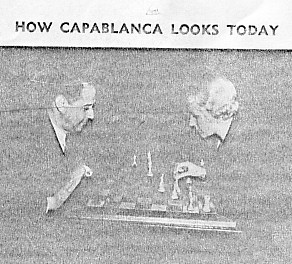
The other item on that page is a crosstable of the ‘Southern California Major League Race’, a chess event won by Beverly Hills with six points out of seven, and we hope that this clue will permit a reader to trace the source and send us a better copy of the above picture.
The second shot comes from the end section of volume one of Capablanca Leyenda y Realidad by Miguel A. Sánchez (Havana, 1978). It is identified as ‘Con Kay Frauce en Hollywood, 1933’, but Kay Francis was meant. [See, however, C.N. 5996.]
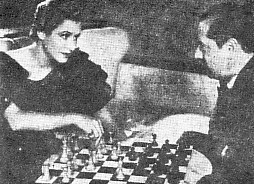
Chess Notes Archives:
| First column | << previous | Archives [1] | next >> | Current column |
Copyright 2004 Edward Winter. All rights reserved.